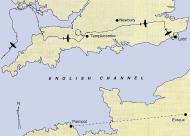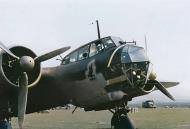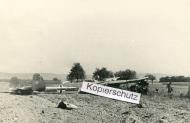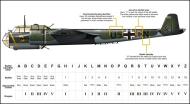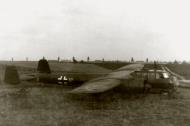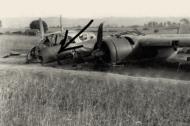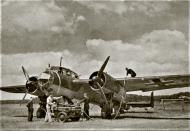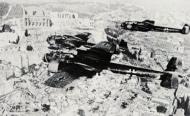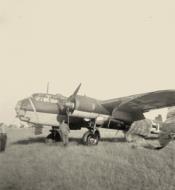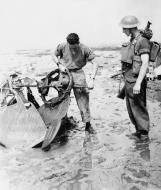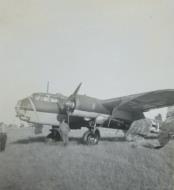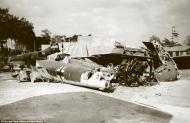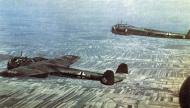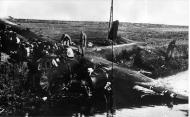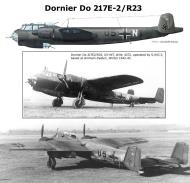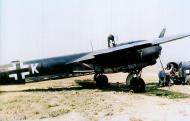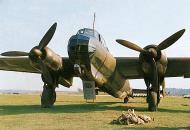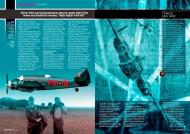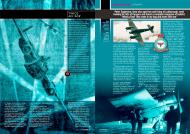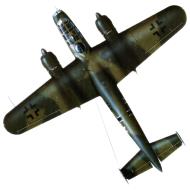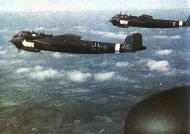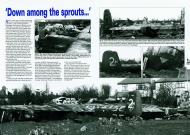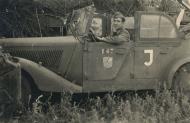Dornier Do 17Z KG2 over the Acropolis Greece 1941
Photo 01: Do 17s of KG2 over the city. Although JG77 took part in the fly-past, operational wear and tear and an acute shortage of spares during the Balkans campaign had seriously affected serviceability and only a few aircraft could participate.
Dornier Dornier Do 17Z 9./KG2 (U5+BT) Cambrai Sud France July 1940
Profile: Flugzeug Classic 2010-07
2. Staffel I. Gruppe Kampfgeschwader 2 'Holzhammer' - 3./KG2
Dornier Do 217M1 2./KG2 (U5+DK) WNr 56031 Stemann crew shot down over Cambridge 23 24th Feb 1944
Photo 01: Dornier Do 217M1 2./KG2 (U5+DK) WNr 56031 Stemann crew shot down over Cambridge 23 24th Feb 1944
3. Staffel I. Gruppe Kampfgeschwader 2 'Holzhammer' - 3./KG2
Dornier Do-217E 3./KG2 (U5+KL) being refueled for another mission
Photo 01: In this photograph Dornier Do-217E-4 code U5+KL of 3./KG2 being refueled prior to a mission. The letter K is painted in yellow and carries a standard factory finish.
II. Gruppe Kampfgeschwader 2 'Holzhammer' - II./KG2 personal emblems
5. Staffel II. Gruppe Kampfgeschwader 2 'Holzhammer' - 5./KG2
Dornier Do 217D 5./KG2 (U5+DN) Dora Nordpol flown by Günther Dolenga ran out of fuel 12th Oct 1941
Photo 01: In fact that photo depicted members of an RAF technical intelligence team clambering over the German bomber and was taken on October 12, 1941 at Jury's Gap Sewer near Rye in Sussex. Downed without firing a shot, the windfall was a most valuable prize; the Do 217 had entered service in the Luftwaffe only a few months earlier and this was the first example to be captured. Afterwards the machine was carefully dismantled and transported to the RAF at Farnborough, where it underwent a more detailed examination and became the subject of numerous reports.
The 'what', the 'where' and the 'when' of the Dornier photo are quickly told. For the 'who', the 'how', and the 'why', it is necessary to probe a bit deeper.
On the evening of October 11, 1941, Oberleutnant Günther Dolenga of 5 Staffel Kampfgeschwader 2 had lifted aircraft U5 + DN - Dora Nordpol off the runway at his base at Evreux in northern France. The four-man crew had been briefed to conduct a lone armed reconnaissance of the sea area to the west of the Scilly Isles and the Irish Sea. If they found any ships, they were to attack them.
No ship was found, and the armed reconnaissance of the sea area went off without incident. Shortly after 0200 hours the following morning, the crew set course for base. Unknown to the airmen, however, that night the wind from the southeast had been rather stronger than forecast. As a result, the north coast of France did not appear at the expected time. Assuming he was flying up the English Channel, at 0230 hours Dolenga turned north. That would allow his observer to get a fix off the south coast of England. About half an hour later a line of breakers obligingly appeared. For several minutes Dora Nordpol cruised up and down the coast as her crew tried to link features seen on the ground with those marked on their map. But the darkness and partial cloud cover rendered this a fruitless exercise. There could be no doubting the existence of that coastline, however, so Dolenga turned southeast and headed the aircraft for the north coast of France. Or so he thought.
Dolenga and his crew had fallen foul of a geographical feature that had caught out, and would continue to catch out, many an airman on both sides. They had mistaken the Bristol Channel for the English Channel. The coastline which had defied identification was not that of the south of Cornwall, but the south of Pembrokeshire. Both were rocky coastlines with few man-made features that could provide unambiguous fixes.
About 20 minutes later Dora Nordpol reached the north coast of Cornwall, which the crew promptly and reasonably assumed to be the north coast of Brittany. In navigational terms their error had been a relatively small one that was unlikely to confuse an experienced airman for long. The observer had tuned the plane's radio compass to the beacon at Paimpol in Brittany. Its Morse identification letters came through loud and clear and the direction-finder needle gave a firm bearing. In normal circumstances the discrepancy between the actual radio bearing and the one expected would have indicated to the crew that they were some distance from where they thought. But these circumstances were anything but normal.
At this time 80 Wing of the RAF was engaged in a long-running campaign to neutralise the various radio navigational systems in use by the Luftwaffe. The Wing is best known for its attack on the Knickebein, X-Gerat and Y-Gerat beam systems used to guide German bombers to their targets during the night blitz of 1940 and 1941. Against these devices the unit employed high-powered jamming transmitters, intended to blot out the beam signals.
That was the 'brute force' approach, but against the German radio beacons the Wing could employ a more subtle method. To defeat these, its chosen weapon was the so-called Meacon, or masking beacon. Under favourable conditions, a Meacon would produce a completely erroneous bearing from a German radio beacon.
The Meacon
The German radio beacons worked in the medium frequency band, and radiated a two-letter Morse identifier that changed from day to day. Following the identifier came a 50-second continuous tone to allow an aircraft's direction-finder to determine the relative bearing of the beacon.
The 80 Wing Meacon comprised a receiver and a transmitter located some distance apart. The receiver was linked to a directional aerial, which picked up the emissions from the German beacon it was to counter. The German emissions were amplified, then fed via a land line to the Meacon. The Meacon radiated on exactly the same frequency as the German beacon, and retransmitted the same Morse identification letters and the 50-second tone exactly in step with the German signals.
This piece of chicanery produced some interesting effects. If the German aircraft was nearer to the beacon than the Meacon, its direction-finder would give a bearing on the real beacon. If the bomber was mid-way between the beacon and the Meacon, the bearing needle might waver between the two as it hunted for the stronger signal. But if the aircraft was nearer to the Meacon than to the beacon, the direction-finder would give a beautifully steady, but quite misleading, bearing on the Meacon transmitter. And the crew of a German aircraft had no way of knowing that this was the case.
On this night, when the observer of Dora Nordpol tuned in his direction-finder to the beacon at Paimpol, the latter was being mimicked by a Meacon situated at Templecombe, near Yeovil. Ignorant of what was afoot, the German crew headed east following the bearing given. Still they did not know where they were, but they were confident that sooner or later they would run across a ground feature they could identify, but it did not happen that way.
Shortly after 0400 hrs Dora Nordpol arrived over the "Paimpol Beacon" in which her crew had placed their truck. The needle of the direction-finder swung round to indicate that the aircraft was directly over the transmitter, yet that did nothing to resolve matters. Paimpol lies on the coast, but as Dolenga circled the source of the radio signal the expected coastline was nowhere to be seen. (Templecombe is well inland). Obviously something was very wrong, so the observer re-tuned the radio compass to the beacon at their base at Evreux. That should solve the problem, he thought.
On that night however, the 80 Wing Meacon near Newbury was covering the Evreux beacon. As the Dornier flew between the British and the German transmitters the needle of the direction-finder wavered all over the place. It seemed that the device had gone haywire, and Dolenga decided to ignore it. He held a heading of 080 degrees, which should have taken the bomber from Paimpol to Evreux. Instead he unwittingly flew from Templecombe almost to Rochester. By 0445 hours dawn was breaking and, some distance ahead and to port, the German crew made out yet another coastline. That looked plausibly like the north coast of France (actually it was the Thames Estuary). With the Dornier running dangerously short of fuel, Dolenga turned south-east on a heading he thought would take him to Evreux.
Imagine then, the consternation in the cabin of the bomber about 10 minutes later when yet another coastline appeared in front of the aircraft. Every part of the plane's navigational equipment was now suspect. Almost out of fuel and with no airfield in sight Dolenga had little alternative but to set the bomber down on open ground. The Dora Nordpol came to rest on the bank of Jury's Gap sewer. The once-proud bomber was a sorry sight. Her back was broken, both propellers had the blades snapped off and one wing under water.
The crew scrambled out of their wrecked Dornier and were amazed to see troops wearing khaki moving towards them. During their next four years in a succession of PoW camps, the men would have plenty of time to ruminate on what had gone wrong on that cold October night. For 80 Wing, the snaring of Dora Nordpol was yet another success to be chalked up by that highly secret unit.
by Dr Alfred Price and acknowledgements to "Flypast"
6. Staffel II. Gruppe Kampfgeschwader 2 'Holzhammer' - 6./KG2
Dornier Do 217E-4 6.KG2-(U5+LP) Hartmut Holzapel WNr 5590 shot down over Grimsby 15th March 1943 all crew became POW's
Dornier Do-217E4 6./KG2 (U5+LP) WNr 5590 crewed by pilot Hartmut Holzapel observer August Kupper engineer Gerhard Dorr and wireless operator Gunter Stein who where assigned as a 'Pathfinder' aircraft were shot down on the night of 15-16 March 1943 whislt trying to attack installations at Grimsby by Beaufighter MkVIf RAF 219Sqn FK-N V8552 flown by nightfighter ace Flt Lt John Willson and nagigator/rador operator Plt Off Holloway who were based at North Riding Scorton. The German crew all became POW's
Source: FlyPast April 2012
9. Staffel III. Gruppe Kampfgeschwader 2 'Holzhammer' - 9./KG2
Dornier Do-217E4 9./KG2 (U5+KT) Dieppe raid France August 19th 1942
Artist: © Arkadiusz Wrobel
Source: "Dieppe 1942. Najwieksza bitwa powietrzna." by Norman L.R.Franks. Seria: KAMPANIE LOTNICZE-NR21. (c) AJ-PRESS, 1999. P.O.Box 98 80-305 Gdansk 5. ISBN 83-7237-029-XDornier Do-217E4 9./KG2 (U5+NT) Werk Nr 4272 Dieppe raid France August 19th 1942
Profile 01: Artist: © Arkadiusz Wrobel
Source: "Dieppe 1942. Najwieksza bitwa powietrzna." by Norman L.R.Franks. Seria: KAMPANIE LOTNICZE-NR21. (c) AJ-PRESS, 1999. P.O.Box 98 80-305 Gdansk 5. ISBN 83-7237-029-X
Kampfgeschwader 2 'Holzhammer' KG2 - Dornier aircraft photo gallery list
Dornier 17Z KG2 U5 lies wrecked over a railway line after crashing over Barham in Kent 1940 01 Dornier Do 17Z 1./KG2 Holzhammer formation with U5+DH foreground Airfix Model World 48 2014 11 Page 058 Dornier Do 17Z 1./KG2 in Tatoi Athens with JG27 aircraft refuelling 1941 ebay 01 Dornier Do 17Z 1./KG2 showing the unit emblem left side Athen Tatoi 1941 01 Dornier Do 17Z 1./KG2 showing the unit emblem right side Athen Tatoi 1941 01 Dornier Do 17Z 2./KG2 U5+DK with U5+KK during the invassion of Belgium France and Holland May 1940 Bund Dornier Do 17Z2 1./KG2 U5+BH which operated over Greece during the Balkans campaign May 1941 0A Dornier Do 17Z2 5./KG2 U5+GN after being salvaged and prepared for rail transport viewed port side ebay 01 Dornier Do 17Z2 5./KG2 U5+GN after being salvaged being frieghted by rail viewed from the starboard side ebay 01 Dornier Do 17Z2 5./KG2 U5+GN crash site viewed from the starboard side ebay 01 Dornier Do 17Z 4./KG2 nose area showing a personal emblem used by one of the groups aircraft left hand side 01 Dornier Do 17Z 4./KG2 U5+CN profile showing Luftwaffe bomber staffel and gruppe letter codes 0A Dornier Do 17Z 9./KG2 U5+BT profile based in Cambrai Sud France July 1940 0A Dornier Do 17Z 9./KG2 U5+BT profile based in Cambrai Sud France July 1940 0B Dornier Do 17Z 9./KG2 U5+GT after force landing during the German offensive Operation Barbarossa 1941 01 Dornier Do 17Z Geschwader Stab KG2 U5+DA in flight over the Balkans 1941 01 Dornier Do 17Z Geschwader Stab KG2 U5+EA 1941 Dornier Do 17Z Geschwader Stab KG2 U5 HA emerging from a hangar 01 Dornier Do 17Z II./KG2 emblem featured on the aircrafts port side 01 Dornier Do 17Z II./KG2 newly painted aircraft makes a nice back drop for crew photos ebay 01 Dornier Do 17Z II./KG2 newly painted aircraft makes a nice back drop for crew photos ebay 02 Dornier Do 17Z III./KG2 crew sit having their lunch on a French airfield prior to their next mission France summer 1940 Dornier Do 17Z KG2 being refueled ebay 01 Dornier Do 17Z KG2 during the invassion of France and Holland May 1940 Bund Dornier Do 17Z KG2 formation overflying the greek Acropolis Athens Greece 1941 01 Dornier Do 17Z KG2 formation overflying the greek Acropolis Athens Greece 1941 02 Dornier Do 17Z KG2 group together using a stepped up Echelon formation 01 Dornier Do 17Z KG2 over the drop zone releases its destructive load during the May days 1940 Bund 13 Dornier Do 17Z KG2 U5+xx salvaged airframe at a holding depot in Elham Kent during the Battle of Britain 1940 01 Dornier Do 17Z Stab II./KG2 U5+GC and U5+MC flying information 1941 Dornier Do 217E 4./KG2 U5+BM and 5./KG2 U5+FN WNr 5532 PI+TJ Dieppe Aug 1942 01 Dornier Do 217E 4./KG2 U5+KM with Robert Heller showing the units assigned code U5 1942 01 Dornier Do 217E4 1./KG2 dispersal area Sep 1942 01 Dornier Do 217E Stab KG2 U5+FA showing the Holzhammer emblem featured on the aircrafts port side 01
Warnemünde Germany Map
Mosjoen harbor Norway Map
Bibliography: +
- Axworthy, Mark, Cornel Scafes and Cristian Craciunoiu. Third Axis, Fourth Ally: Romanian Armed Forces in the European War, 1941–1945. London: Arms and Armour Press, 1995. ISBN 1-85409-267-7.
- Bergström, Christer. Barbarossa - The Air Battle: July-December 1941. London: Chervron/Ian Allen, 2007. ISBN 978-1-85780-270-2.
- Bungay, Stephen. The Most Dangerous Enemy: A History of the Battle of Britain. London: Aurum Press, 2000. ISBN 1-85410-721-6(hardcover), ISBN 1-85410-801-8 (paperback 2002).
- de Zeng, H.L., D.G. Stanket and E.J. Creek. Bomber Units of the Luftwaffe 1933-1945: A Reference Source, Volume 1. London: Ian Allen Publishing, 2007. ISBN 978-1-85780-279-5.
- de Zeng, H.L., D.G. Stanket and E.J. Creek. Bomber Units of the Luftwaffe 1933-1945: A Reference Source, Volume 2. London: Ian Allen Publishing, 2007. ISBN 978-1-903223-87-1.
- Ciglic, Boris and Dragan Savic. Dornier Do 17 - The Yugoslav Story: Operational Record 1937-1947. Belgrade: Jeroplan Books, 2007. ISBN 978-8-69097270-8.
- Dressel, Joachim and Manfred Griehl. Bombers of the Luftwaffe. London: DAG Publications, 1994. ISBN 1-85409-140-9.
- Goss, Chris. Dornier 17: In Focus. Surrey, UK: Red Kite Books, 2005. ISBN 0-9546201-4-3.
- Green, William. Warplanes of the Second World War, Volume Eight, Bombers and Reconnaissance Aircraft. London: MacDonald. 1967.
- Green, William and Gordon Swanborough. 'The Annals of the 'Pencil': The Story of the First-Generation Dornier Do 17'. Air Enthusiast. Issue 30, March—June 1986. Bromley, Kent, UK: Pilot Press, pp. 38–53. ISSN 0143-5450.
- Green, William and Gordon Swanborough. 'Balkan Interlude - The Bulgarian Air Force in WWII'. Air Enthusiast. Issue 39, May–August 1989. Bromley, Kent: Tri-Service Press, pp. 58–74. ISSN 0143-5450.
- Griehl, Manfred. Dornier Do 17E-Z, Do 215B; The Flying Pencil in Luftwaffe Service. World War Two Combat Aircraft Archive No. 03. Air Coc, Erlangen, Germany, 2005. ISBN 3-935687-42-7.
- Hooton, E.R. Luftwaffe at War; Gathering Storm 1933-39: Volume 1. London: Chervron/Ian Allen, 2007. ISBN 978-1-903223-71-7.
- Hooton, E.R. Luftwaffe at War; Blitzkrieg in the West: Volume 2. London: Chervron/Ian Allen, 2007. ISBN 978-1-85780-272-6.
- Keskinen, Kalevi and Kari Stenman. Suomen Ilmavoimien historia 2: Dornier Do 17Z, Junkers Ju 88A-4. Hobby-Kustannus Oy, 1999. ISBN 952-5334-01-5.
- March, Daniel J. British Warplanes of World War II. London: Aerospace Publishing. 1998. ISBN 1-874023-92-1.
- Munson, Kenneth. Fighters and Bombers of World War II. London: Peerage Books. 1983. ISBN 0-9-0740-837-0
- Nedyalkov, Dimitar. Air Power of the Kingdom of Bulgaria. Volume IV. FARK OOD, Sofia, 2001. ISBN 978-9549669794.
- Neulen, Hans Werner. In the Skies of Europe: Air Forces Allied to the Luftwaffe 1939–1945. London: Crowood, 2000 ISBN 1-86126-326-0.
- Nowarra, Heinz J.The Flying Pencil. Atglen, Pennsylvania: Schiffer Publishing, 1990. ISBN 0-88740-236-4.
- Schlaug, Georg. Die deutschen Lastensegler Verbände 1937–1945. Stuttgart: Motorbuch, 1985. ISBN 3-613-01065-8.
- Smith, J.R. The Do 17 and Do 215 (No. 164). London: Profile Publications, 1967.
- Smith, J.R. and Antony L. Kay. German Aircraft of the Second World War. London: Putnam, 1990. ISBN 85177-836-4.
- Staerck, Christopher and Paul Sinnott. Luftwaffe: The Allied Intelligence Files. Washington, DC: Potomac Books, 2002. ISBN 978-1-57488-387-9.
- Wrobel Arkadiusz. Dornier DO 17/DO 215. Monograph Series 39. Kagero Oficyna Wydawnicza. 2008. ISBN 978-8361220107
Magazine References: +
- Airfix Magazines (English) - http://www.airfix.com/
- Avions (French) - http://www.aerostories.org/~aerobiblio/rubrique10.html
- FlyPast (English) - http://www.flypast.com/
- Flugzeug Publikations GmbH (German) - http://vdmedien.com/flugzeug-publikations-gmbh-hersteller_verlag-vdm-heinz-nickel-33.html
- Flugzeug Classic (German) - http://www.flugzeugclassic.de/
- Klassiker (German) - http://shop.flugrevue.de/abo/klassiker-der-luftfahrt
- Luftwaffe IM Focus (German) - https://www.luftfahrtverlag-start.de/
- Embleme der Luftwaffe Band-1 (German) - https://www.luftfahrtverlag-start.de/
- Le Fana de L'Aviation (French) - http://boutique.editions-lariviere.fr/site/abonnement-le-fana-de-l-aviation-626-4-6.html
- Le Fana de L'Aviation (French) - http://www.pdfmagazines.org/tags/Le+Fana+De+L+Aviation/
- Osprey (English) - http://www.ospreypublishing.com/
- Revi Magazines (Czech) - http://www.revi.cz/
Web References: +
- Wikipedia.org - http://en.wikipedia.org/wiki/Arado_Ar_196
 Editor for Asisbiz: Matthew Laird Acred
Editor for Asisbiz: Matthew Laird Acred
If you love our website please add a like on facebook
Please donate so we can make this site even better !!

